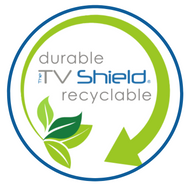Going Green and Sustainability with The TV Shield (Outdoor TV Enclosure)
Posted by Emilyann Allen on 31st Jul 2024
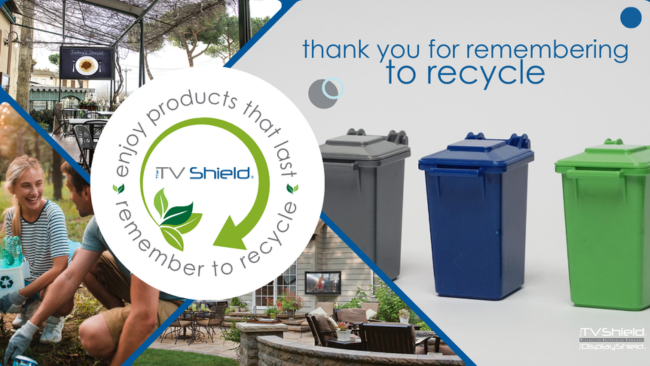
Table of Contents:
Understanding Outdoor TV Enclosure Materials
Environmental Impact of Materials
The TV Shield and Sustainability
The Recycling Process for TV Enclosure Materials
Breaking Down Materials Without Harming the Environment
The Importance of Mindful Recycling
Outdoor TV Enclosure Recycling: The TV Shield and More
In an era where sustainability is more than a buzzword, all products including The TV Shield have become relevant in the conversation about environmental responsibility. Are there eco-friendly outdoor TVs? This article delves into the materials used in outdoor TV enclosures such as TheTVShield – HMWPE polymer, steel, polycarbonate, metal, and aluminum. The following provides an overview of environmental impacts, effective recycling strategies, ways The TV Shield is proactive and an industry leader in going green efforts, and how everyone can contribute to a greener future. If your aim is to have an eco-friendly outdoor TV, green outdoor TV, or sustainable outdoor TV, this article may help guide your decision-making by explaining the outdoor TV enclosure option and materials used in outdoor TV enclosures. We live in times when it makes such a difference to be mindful of resources and recycle. So, Protective Enclosures Company produces long-lasting products that have long life cycles to reduce high product turnover, utilizes recycling practices when able, and strongly encourages customers to recycle. Please remember to recycle.
Understanding Outdoor TV Enclosure Materials
Here is an overview of common outdoor TV enclosure materials. Learn more about responsible manufacturing and effective recycling strategies for outdoor TV enclosures further within this article.
HMWPE Polymer
High Molecular Weight Polyethylene (HMWPE) is widely used in outdoor applications due to its robustness and resistance to environmental factors like UV radiation and corrosion. Its strength is beneficial for products that need to withstand harsh conditions, making it an ideal choice for outdoor TV enclosures like TheTVShield. Efforts to recycle HMWPE are essential to mitigate its environmental footprint.
Steel
Steel's durability and strength make it an essential material in various industries, including consumer electronics. Steel recyclability is high and a significant environmental advantage. Innovations in steel production, such as electric arc furnaces and increased use of scrap steel, are helping to reduce these environmental impacts.
Polycarbonate
Polycarbonate is known for its transparency and impact resistance, making it ideal for weatherproof protective enclosures. The recycling of polycarbonates is possible.
Aluminum
Aluminum is highly valued in sustainable product design due to its recyclability and lightweight nature. It requires only 5% of the initial energy used to produce it from raw materials when recycled, significantly reducing its environmental impact. The Aluminum Association states that nearly 75% of all aluminum ever produced is still in use today, thanks to recycling. Its corrosion resistance also contributes to the longevity of products, reducing the need for frequent replacements and further minimizing environmental impact.
The key to mitigating the environmental impact of these materials lies in responsible manufacturing practices, advanced recycling technologies, and conscious consumer choices.
Environmental Impact of Materials
Is there a sustainable outdoor TV enclosure?
This may not be a yes or no answer since many factors come into play. Going green is a complex topic with many perspectives to consider. So, is there a green outdoor TV enclosure, sustainable outdoor TV cabinet, or eco-friendly outdoor TV enclosure? You are invited to decide what you think about the topic and the following information may help. The following is a deep dive into common materials used to manufacture outdoor TV enclosures followed by how outdoor TV enclosures can be recycled.
HMWPE
High Molecular Weight Polyethylene (HMWPE) is a strong and durable material. Its production and disposal have significant environmental repercussions when handled poorly. On the topic of HMWPE environmental impact - being plastic, HMWPE is derived from non-renewable fossil fuels, contributing to carbon emissions and the depletion of these resources. According to sciencedirect.com, if not recycled properly, HMWPE contributes to plastic pollution, which is a growing global environmental issue. Its resistance to degradation means it can persist in the environment for centuries, potentially harming wildlife and ecosystems. On the flip side when used for a long-term durability product, it can be an advantage that the item can be used for a long time and then recycled (preventing having to frequently purchase new replacement enclosures and TVs they protect). One of the first recommended ways to go green is to choose long-lasting products. To reduce HMWPE environmental impact, Protective Enclosures Company (makers of The TV Shield and The Display Shield) encourages customers to reach out to local recycling facilities if you’re ready to recycle your enclosures. When doing a basic Google search, you may even find companies willing to pay for scrap and old plastics and metals, such as Oneida-Herkimer Solid Waste Authority and Reily Recovery Systems.
Steel
Steel is highly recyclable, which mitigates some of its environmental impacts. However, its production process is carbon-intensive. According to the World Steel Association, for every ton of steel produced, about 1.85 tons of carbon dioxide is emitted. This accounts for about 7-9% of global carbon dioxide emissions from fossil fuel use. Steel recyclability helps but while recycling steel reduces the need for new raw materials and the associated environmental impact, the initial production process remains a significant source of greenhouse gas emissions. The good news is that according to the American Iron and Steel Institute, steel is the most recycled material on the planet, with a recycling rate of 68% in North America. Everyone (consumers and companies alike) who opt to recycle used steel and manufacturing facilities utilizing recycled steel makes a positive impact.
Polycarbonate
Polycarbonate's environmental impact primarily stems from its chemical composition, including the use of Bisphenol A (BPA). The production of polycarbonates releases BPA and other potentially harmful chemicals into the environment. BPA has been identified as an endocrine disruptor, which can affect wildlife and human health. Moreover, the disposal and degradation of polycarbonates can lead to further release of these chemicals into the environment, posing additional ecological risks. Specialized recycling processes are required to safely recycle this material, and advancements in chemical recycling techniques are making this more feasible. This is why it is very helpful for anyone (consumers and businesses) handling polycarbonate to recycle the material anytime it is possible. And this is also why it is encouraging to live in a time when industries are working to find ways to safely reuse materials like this. Working together, we can all achieve a cleaner planet. Reily Recovery Systems is one option to consider for polycarbonate recycling.
Aluminum
Aluminum is notable for its sustainability, primarily due to its high recyclability and the lower energy requirements in its recycling process compared to primary production. Recycling aluminumsaves about 95% of the energy required to produce aluminum from raw materials, significantly reducing its environmental impact. This makes aluminum a more eco-friendly option, as it lessens the demand for primary aluminum production and its associated environmental costs.
The TV Shield and Sustainability
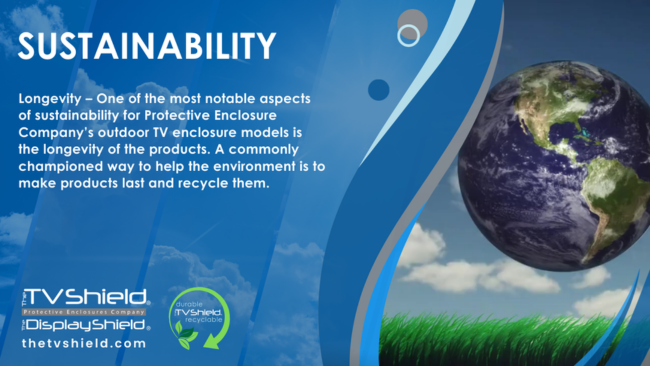
Here are ways The TV Shield is involved with or encourages sustainability, going green, or recycling.
● Longevity – One of the most notable aspects of sustainability for Protective Enclosure Company’s outdoor TV enclosure models such as The TV Shield, The Display Shield, The TV Shield, and more is the longevity of the products. A commonly championed way to help the environment is to make products last and recycle them. Quality outdoor TV enclosures like The TV Shield support longevity goals by helping TVs last far longer. The enclosures themselves also utilize long-lasting materials (some materials that last 20+ years) in harsh environments, meaning they will rarely need to be replaced or recycled.
● Sustainability Manufacturing Practices – The TV Shield’s HMWPE outdoor TV enclosures utilize HMWPEsheets that are created from regrind material whenever possible. Reuse and recycling of materials when possible is a helpful practice, in fact, “recycled plastic pellets and regrind are one of the easiest, most cost-efficient ways to reduce your carbon footprint,” (Greenpath). Additionally, all plastic scraps in The TV Shield and The Display Shield manufacturing facility are sent for recycling. All aluminum scraps in The TV Shield PRO manufacturing facility are also recycled. Sustainable manufacturing practices are on the rise and at PEC we are excited to see what possibilities are to come. Here at Protective Enclosures Company, we are grateful for recycling and reuse practices in the manufacturing industry and aim to help customers enjoy TV outside while also keeping sustainability in mind.
● Recyclability – What are TV enclosure recycling options for The TV Shield and other Protective Enclosures Company enclosures? Having researched and spoken with sustainability experts, Protective Enclosures Company is excited to make sure our customers know recycling outdoor TV enclosure materials is often simple. Many materials are recyclable locally for many people. Simply perform a Google search, identify local recycling companies that handle the material in question, and follow the company's guidelines for how to submit the materials to them. In some cases, the enclosure may need to be disassembled and the parts give to different recycling facilities. Some companies even pay for these recyclable materials such as HMWPE polymer (The TV Shield and The Display Shield back housing), aluminum (The TV Shield PRO front frame), steel (The TV Shield PRO back housing), ABS plastic (The TV Shield E-Series housing), and polycarbonate (clear front enclosure panels). Small parts and components are also often locally recyclable. At PEC, we strongly encourage TV enclosure recycling when the time comes and effective recycling strategies with any relative packaging or products in daily life.
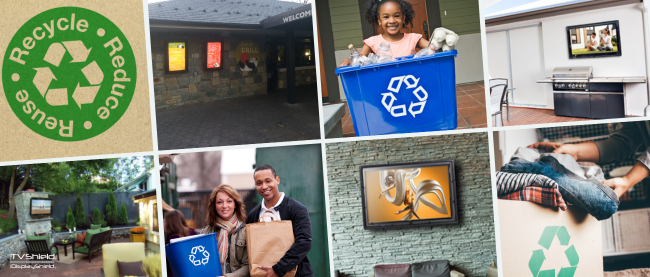
More About the Recycling Process for TV Enclosure Materials
What happens to these materials when they are recycled? Read on to learn more.
Steel and Aluminum Recycling
The recycling process for steel and aluminum is more straightforward and well-established. Steel can be recycled indefinitely without loss of quality, and its recycling process is widely available across the globe. Similarly, aluminum is one of the most recycled materials, and its recycling process is both energy-efficient and effective in reducing the need for primary aluminum. An easy solution is simply to perform a Google search for the steel or aluminum recycler you prefer to use.
HMWPE and Polycarbonate Recycling
Recycling HMWPE and polycarbonate requires specialized facilities capable of handling their chemical composition and potential environmental hazards. For HMWPE, the recycling process often involves mechanical recycling methods, including grinding, melting, and reforming the material. Polycarbonate recycling, however, may involve more complex processes such as chemical recycling, where the material is broken down into its chemical components before being reconstituted. This process is essential to safely remove additives like BPA and ensure the material is recycled without harming the environment. This is why Protective Enclosures Company strongly encourages customers to recycle their outdoor TV enclosures if and when the time comes.
While each material in The TV Shield has its unique environmental considerations, advancements in material sourcing, recycling technologies, and responsible waste management practices can significantly mitigate these impacts. We look forward to the continued improvements of available options for eco-friendly manufacturing and appreciate our amazing partners and customers who care about these topics. Proper recycling of these materials not only conserves resources but also reduces pollution, making it a crucial aspect of sustainable product lifecycle management.
Breaking Down Materials Without Harming the Environment
What sustainability progress has been made and what does the future hold? Innovative recycling methods are continually being developed to minimize environmental harm; some of these methods are included below.
Chemical Recycling
This process breaks down plastics into their basic chemical elements, which can then be reused to create new plastic products. This method is particularly useful for polymers like HMWPE and polycarbonates that are difficult to recycle using traditional methods.
Bio-based Recycling Solutions
Researchers are exploring the use of enzymes and other biological agents to break down plastics. For example, a study published in "Nature" detailed an engineered enzyme that can rapidly break down PET, a type of plastic commonly used in bottles.
Thermal Decomposition
This method involves breaking down materials at high temperatures in the absence of oxygen. It is useful for materials like certain polymers and composites that are not easily recyclable through conventional means.
It is exciting to live in a time where recycling science has come a long way and there are many possibilities to mindfully handle materials.
The Importance of Mindful Recycling
Environmental Benefits
Mindful recycling plays a crucial role in reducing landfill waste, pollution, and resource depletion. By recycling materials effectively, we can decrease the demand for new raw materials, thereby reducing the environmental impact associated with extraction and processing. For instance, the recycling of aluminum saves around 95% of the energy required to produce it from raw materials, according to the Aluminum Association.
Long-term Sustainability
Sustainable recycling practices contribute to the long-term sustainability of our planet. They ensure that resources are available for future generations and help maintain ecological balance. By adopting more efficient recycling methods and reducing waste, we can mitigate the effects of climate change and preserve natural habitats.
How Everyone Can Contribute
Individual Efforts in Recycling
Every individual can make a significant impact through small, consistent actions. This includes properly sorting waste, choosing products with recyclable materials, and supporting brands that prioritize sustainability. For example, participating in local recycling programs and reducing single-use plastics in daily life can collectively lead to significant environmental improvements.
Community Initiatives
Community-driven recycling programs can greatly amplify the impact of individual actions. These initiatives often involve collective efforts in waste management, educational programs, and local recycling drives. A well-known example is the community recycling program organized by TerraCycle, which engages communities in collecting and recycling hard-to-recycle materials.
By understanding and implementing advanced recycling techniques, recognizing the importance of mindful recycling, and engaging in both individual and community efforts, we can make substantial strides toward environmental sustainability. While these practices are evolving, their implementation is crucial for the preservation of our planet for future generations.
The movement towards sustainability is not just an individual effort but a collective responsibility. Recognizing the environmental impact of materials, actively seeking out and utilizing recycling options, and participating in both individual and community-level sustainability actions are pivotal. This journey towards a more sustainable future requires consistent effort and dedication from all stakeholders – manufacturers, consumers, and governments alike. Protective Enclosures Company's mission is to treat every person as you would want to be treated, be efficient, continue to innovate, and always give back. Let’s continue to create a happier world for all. Join us in staying informed, using long-lasting products, and recycling when possible.
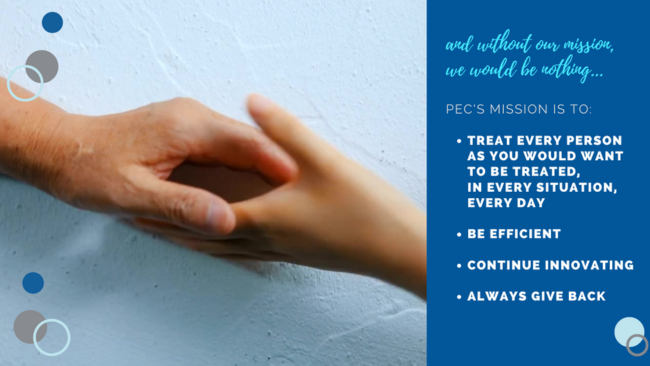
FAQs
What is the environmental impact of HMWPE polymer?
HMWPE polymer, while durable, is derived from fossil fuels and can contribute to plastic pollution if not recycled properly. Its production is energy-intensive and generates greenhouse gasses, while its disposal can lead to long-term environmental contamination. However, there are now recycling programs in place that help reduce these impacts.
How can steel from products like The TV Shield be recycled?
Steel can be recycled through standard recycling facilities. It involves melting down the steel and reforming it into new products. Since steel does not lose its strength or quality through recycling, it can be recycled indefinitely, reducing the need for new raw material extraction.
Are there special considerations for recycling Lexan® polycarbonate?
Yes, Lexan® polycarbonate requires specialized recycling processes due to its chemical composition, including BPA. It typically undergoes mechanical or chemical recycling to safely break it down and repurpose it, ensuring that harmful substances are not released into the environment. Consider options like ReilyRecoverySystemswhen recycling this material.
What makes aluminum a sustainable choice for The TV Shield?
Aluminum is highly recyclable and requires significantly less energy to recycle than to produce from raw materials. Its recyclability, combined with its durability and lightweight nature, makes it a more sustainable option, reducing both resource depletion and energy consumption.
How can individuals contribute to the recycling of complex products?
Individuals can contribute by properly disposing of complex products at dedicated recycling centers or participating in take-back programs offered by manufacturers. Educating oneself about the specific recycling needs of complex products and spreading awareness within the community are also important steps.
Are there sustainable outdoor TVs?
TV manufacturers are developing ongoing ways to make indoor TVs more sustainable such as thinner TVs that use fewer materials, more energy-efficient TVs, and more. In the outdoor TV world, manufacturers like The TV Shield encourage choosing long-lasting outdoor TV enclosures that lengthen the lives of TVs and contribute to sustainability goals.
Can outdoor TV enclosures be recycled?
Yes, most outdoor TV enclosures can be recycled. This is great news for the planet. When it is time to recycle an outdoor TV enclosure, a metal or outdoor plastics recycling company can typically be found online (sometimes locally and some companies even pay for these materials).
How can I recycle an outdoor TV enclosure?
Recycling outdoor TV enclosure materials is often simple. Many materials can be recycled locally. Perform a quick Google search, identify local recycling companies that handle the material in question, and follow the company's guidelines for submitting the materials to them. Some companies even pay for these recyclable materials such as HMWPE polymer (The TV
Shield and The Display Shield back housing), aluminum (The TV Shield PRO front frame), steel (The TV Shield PRO back housing), ABS plastic (The TV Shield E-Series housing), and polycarbonate (clear front enclosure panels). Small parts and components are also often locally recyclable.

